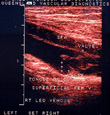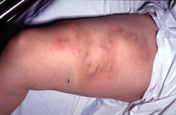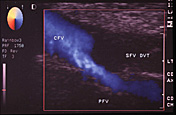AIM:
To examine both the deep and superficial veins in the leg to confirm or exclude the presence of thrombosis (blood clots).
PATIENT PREPARATION:
The patient will need to have the leg under investigation bare from the groin to the foot. Thus they should wear loose fitting clothes or be prepared to remove the outer garments of the lower extremity. Patients of course will be provided with a gown and the investigation is performed in complete privacy.
TECHNIQUE:
The patient is usually examined in a lying position although they may occasionally be required to stand. The study is non-invasive and does not involve the injection of any dye. Gel is applied to the skin and the ultrasound probe is run up and down the leg following the veins. The sonographer may be required to squeeze the patient’s calf to stimulate blood flow in the veins of the leg. Occasionally the probe will have to be pushed quite firmly to assess the deeper veins. The major abdominal veins may need to be investigated which may require the patient to fast and in this case the probe will be applied to the patient’s abdomen. Study Time – The investigation will require approximately 30 minutes per leg.
DIAGNOSTIC CRITERIA:
The diagnosis of thrombosis in a vein is confirmed by the demonstration of incompressibility of the vein to pressure by the probe and the absence of any flow in the vein. Partial non-occlusive thrombosis may be seen. The study is more accurate in the larger veins above the knee and less so in the smaller veins below the knee.
Click here to view the worksheet.



